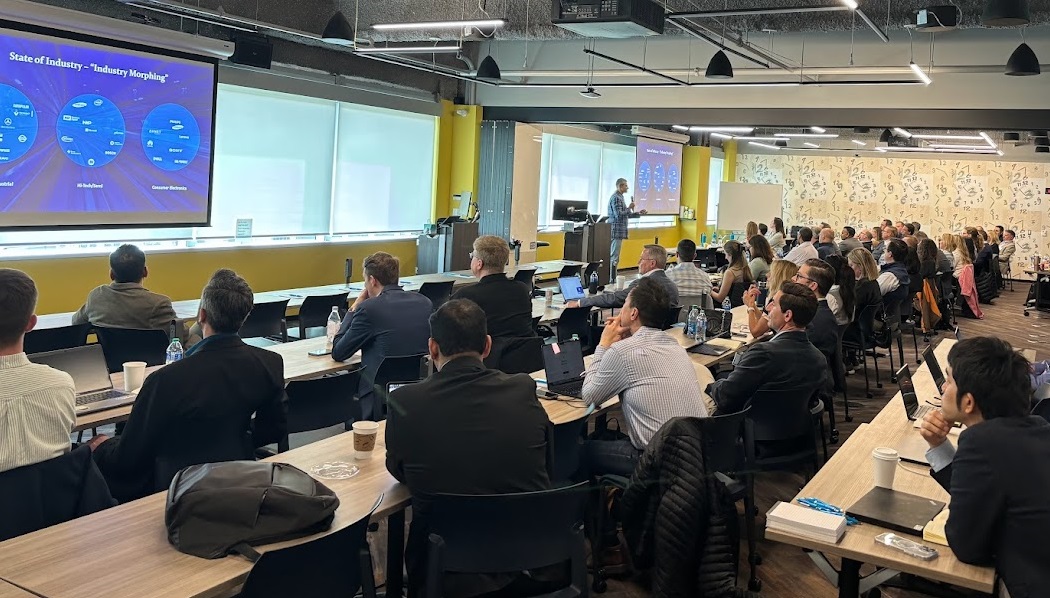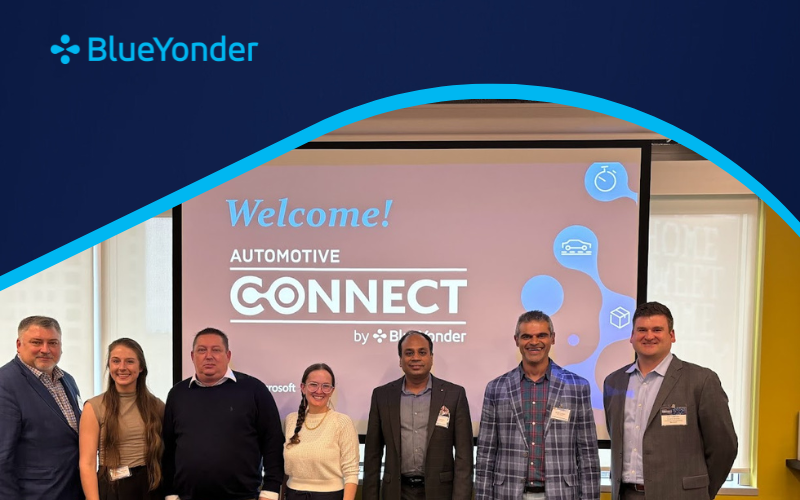Blue Yonder and Microsoft co-hosted the annual Blue Yonder Automotive Connect event in Detroit, Michigan, bringing together 67 supply chain practitioners from 15 companies in the Automotive OEM, Tier 1, and Aftermarket sectors. The event featured engaging speakers from Daimler Truck, Ford, Subaru Canada, Mercedes-Benz USA, Panasonic Automotive, and flexis. This annual gathering serves as a platform for sharing ideas on supply chain innovations and attracts repeat attendees from the automotive industry community.

Key Takeaways:
- Industry Morphing: Salim Shaikh, Automotive Industry Strategy at Blue Yonder, highlighted how the automotive landscape is shifting towards differentiation through advanced technologies such as ADAS, infotainment, telematics, LiDAR sensors, image recognition, 5G communications, and electric powertrains. The convergence of industries, known as “Industry Morphing,” is blurring traditional boundaries, and automotive winners are expected to operate as technology companies integrating best practices from both the high-tech and consumer industries. Early evidence of the effect of this convergence can be seen from the recent chip shortage that has plagued OEM assembly lines.
- Configured-To-Order, Nearshoring/Onshoring, Supply Chain Visibility and Omni-Channel Fulfillment: Salim Shaikh also highlighted the key trends facing automotive including the hybrid “Push” and “Pull” configured-to-order models, the impact of nearshoring/onshoring on factory planning, and the importance of illuminating the supply chain network for visibility and risk mitigation. The emphasis was on creating a connected, agile, and responsive supply chain closer to customer demand and incorporating omni-channel fulfillment and ensuring a seamless customer experience. Additionally, Salim highlighted the role of emerging technologies like artificial intelligence (AI)/machine learning (ML) and, more recently, generative AI in effectively addressing these evolving trends.
- Leadership and People Drive Change: Frederiek Toney, former President of Global Ford Customer Service, underscored the vital role of supporting one’s team and recognizing the substantial time required for organizational adaptation and transformation. Toney introduced the three P’s of change – Passionate, advocating for a culture that enthusiastically embraces change; Purposeful, emphasizing strategic preparation and implementation of change; and Perpetual, highlighting the continuous need for adaptation and evolution. The focus was on building effective relationships, influencing leaders, and fostering internal evolution as essential pathways to successful change. Kiki Nice, Manager of Supply Chain at Daimler Truck, shared instances of insourcing 3PL, illustrating the pivotal role of people and leadership in instigating change and establishing a framework of trust with accountability drivers.
- Journey Towards a Resilient Supply Chain: Ed Lesnau, Industry Executive in Mobility & Manufacturing Strategy, Microsoft, delineated the complex responsibilities faced by Supply Chain leaders. These encompassed the imperative to enhance visibility across supply chain functions, pursue cost optimization and efficiency improvements, and meet customer demands in a sustainable and effective manner. Lesnau emphasized a three-phase approach to building resilient supply chains: Connected, Predictive, and Prescriptive/Autonomous. This framework underscores the progression towards heightened automation and proactive decision-making as integral elements of achieving resilience.
- Right Parts, Right Place, Right Time and Enhanced Visibility, Responsiveness, and Automation: Ashleigh Stone, representing Mercedes-Benz USA (MBUSA), addressed the intricate challenges the company encounters in its operations. These challenges involve grappling with extended lead times for parts inventory and navigating limitations in distribution center (DC) space. MBUSA is confronted with the task of creating highly precise forecasts and optimizing inventory levels, made more complex by the heightened volatility in demand. Compounded by the fact that MBUSA sources parts from Germany, the company must adeptly handle uncertainties on the fulfillment side, including managing elevated transportation costs, navigating blocked shipping lanes, and addressing labor shortages. Looking to the future, MBUSA has established strategic objectives that underscore the critical importance of visibility, responsiveness, and a concerted effort to reduce manual processes through heightened automation. These goals align seamlessly with the broader industry’s emphasis on enhancing efficiency and agility. In pursuit of these objectives, MBUSA has formed a strategic partnership with Blue Yonder to drive tangible improvements in customer service levels and optimize the inventory mix — ensuring the right parts are in the right place at the right time.
- Supply Chain Challenges and Opportunities: Insights from Industry Leaders: Panel discussions featuring Manoj Tiwary, Chief Information Officer at Subaru Canada; Kiki Nice, Manager of Supply Chain at Daimler Truck; Doug Cantriel, Head of North American Transportation and Modernization at Ford; and Philipp Beißwenger, Head of flexis, unveiled the current state of supply chains. Kiki Nice deliberated on the business viability of electric vehicles (EVs) while contending with environmental challenges related to battery storage and recycling, and Manoj Tiwary concentrated on establishing transparent and resilient systems to adeptly navigate swift changes in the industry. Throughout the discussions, panelists and speakers underscored the necessity for continuous learning and adaptability in response to industry shifts. Doug Cantriel emphasized the significance of challenging established processes and cultivating a culture where teams feel empowered to challenge leadership. Kiki Nice delivered closing comments, emphasizing the significance of events like this for continuous learning and development, while highlighting the role of providing tools and resources for success.
To learn more about the future of automotive, please visit this blog: Driving the Future of Automotive — Connected, Autonomous, Electric, Configure to Order.

